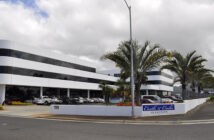For decades there has been an ongoing and intensifying debate about the security of the North West of Western Australia, which is coveted for its abundant natural resources, particularly in oil and gas reserves. In an exclusive interview, the CEO of the Dampier Port Authority, Steve Lewis, articulated his views to Sergei DeSilva-Ranasinghe, on the importance of the Dampier Port, North West maritime security, perceived threats to the region, how Defence sees the North West, the feasibility of creating a large and permanent population base in the Pilbara, and the need to have greater ADF visibility in the region.
To start with, can you explain why the Dampier Port is considered to be so important to the national interest?
Dampier is the third-largest bulk export port in the world; Port Hedland is the second-largest, while the largest is in China. Dampier is the second largest tonnage port in Australia because we have iron ore as well as the oil and gas industry here. However, Dampier is the most active port in Western Australia in terms of those ship movements, cargo handling – but we’re not the biggest port by tonnage; that is Port Hedland and about 89 percent of their trade is iron ore. While we have a lot of iron ore export, it’s the other trade that really creates a lot of the activity here.
Dampier is a gateway port and a protected harbour port which about is 20 km wide and 30 km out into the ocean. The 42 islands just out from here break up the wave movements so you will find that we have a reasonably good sea state most days, not without exception. Dampier Port is one of the eight State owned ports in Western Australia. Construction of the Dampier Port started back in 1962 and the Dampier Port Authority (DPA) itself didn’t come along until 1989. It’s one of the few places along the Western Australian North Coast with sheltered areas which are good for mooring, so we have 230 odd moorings in the port. We have a lot of smaller industry crafts, barges, cranes and tugs, which can fit in this port quite well because of that island configuration.
About 99 percent of the assets in the port are privately owned. In total, we’ve got six berths here and a salt berth. In terms of berths we can start to the West of us where we have Rio Tinto’s facilities. The first of those is a single salt berth at Mistaken Island. Next to that they have East Intercourse Island which has got two berths where they can load about 40 million tons, while the remainder of their tonnage in Dampier is done out of Parker Point, which has four berths. Rio Tinto has its own channel in the port, and is sailing three ships on a tide and operating a very efficient operation. If we come over to the eastern side of the port we’ve got LNG berths, two are with the North West Shelf venture and one is with the Woodside Pluto Project. And then for general cargo the DPA has a cargo wharf which was built by the North West Shelf venture when DPA first started and was later transferred to the State. The State extended this in 1994-95. So you can berth six or seven vessels over at the Rio side, and on the eastern side you can berth four vessels. We also have seven berths on the general cargo for the smaller vessels.
As for the numbers of vessels entering major WA ports in the North West, it would probably be upwards of 10,000 vessels, but Dampier alone has over 6,400 ships visit annually. About 1,300 of those are bulk carriers and LNG vessels, which is the major trade of the port. All the others are the rig tenders and cargo vessels. While general cargo is a small part of our trade in tonnage terms, it’s actually a large part of our activity because for the offshore oil and gas industry of the North West Shelf. Dampier is where they service and supply their vessels in the main and a lot of our activity is just that. We get around 21,000 vessel movements in the port and a lot of shifting of cargo, food and supply for the rigs offshore and the floating platforms. Just about any type of vessel that you can think of is somewhere in the port of Dampier; barges, cranes, jack-up rigs, maintenance vessels and rig tenders. The size of the ships that enter the ports in the Pilbara region are around 140,000-160,000 Dead Weight Tons (DWT) which is the capesize class that loads iron ore. At Cape Lambert you’ll get in more 160,000-180,000 DWT capesize, but you’ll find that in Port Hedland they can get in ships up to 350,000 tons. Between the three ports in the area we account for just under 40 percent of Australia’s exports by dollar value, and by volume WA has 74 percent of the nation’s export by tonnage. Obviously the Pilbara is a high percentage of that. You can see WA is significant in the national economy because it’s a big resource State but also the ports in the Pilbara are quite significant. It’s also in the Indian Ocean with our nearest neighbours such as Indonesia. Being up here in the Pilbara you get a clear sense that we are the part of Australia that is the closest to the rest of the world. The growth is in Asia and India, so the Pilbara is well placed.
Moving to the topic of the region’s security, can you describe the maritime security concerns that are unique to the North West of WA?






